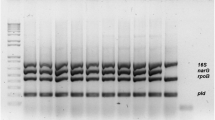Abstract
Pseudotuberculosis is an acute infectious disease caused by Yersinia pseudotuberculosis. In the 1950 and 1960s, outbreaks of a new, previously unknown disease were registered in the Far East of Russia, called the “Far East scarletlike fever” (FESLF). FESLF is pseudotuberculosis, which has a specific clinical form. The disease is endemic to the Far Eastern, Siberian, and Northwestern regions of Eurasia. At present, there is only one system designed to detect Y. enterocolitis and Y. pseudotuberculosis for diagnostics by polymerase chain reaction. The disadvantage of this system is the lack of the possibility for the specific detection of Y. pseudotuberculosis. In this work, 35 strains of Y. pseudotuberculosis were characterized by the detection of the plasmid gene encoding the adhesin (yadA), MLST typing, and detection of the chromosomal gene of the Y. pseudotuberculosis—the cytotoxic necrotizing factor (cnfY). Detection of the yadA gene correlated with presence of the plasmid (pYV). The strains belonged to five MLST sequence types (STs), one of which, ST240, was described for the first time. All the studied strains of Y. pseudotuberculosis showed the presence of the cnfY gene. Additionally, the results of 68 previously described Y. pseudotuberculosis strains were analyzed. A total of 103 strains showed two allelic variants. Allele 1 was found in all strains isolated from patients with FESLF. The cnfY gene was not specifically associated with the presence of plasmids. The cnfY gene was absent in the Y. enterocolitica strains. Thus, the cnfY gene is a stable and specific marker of Y. pseudotuberculosis. On the basis of the obtained data, a PCR diagnostic system was developed for the detection and intraspecific differentiation of Y. pseudotuberculosis by determining the cytotoxic necrotizing factor gene in the biomaterial.



Similar content being viewed by others
REFERENCES
Kuznetsov, V.G., Role of the habitat of extra-organismal pathogen population for epidemiology of pseudotuberculosis, Zh. Mikrobiol., 1997, no. 5, pp. 17–22.
Williamson, D.A., Baines, S.L., Carter, G., Silva, A.G., Ren, X., Sherwood, J., et al., Genomic insights into a sustained national outbreak of Yersinia pseudotuberculosis, Genome Biol. Evol., 2017, vol. 8, no. 12, pp. 3806–3814.
Le Guern, A.S., Martin, L., Savin, C., and Carniel, E., Yersiniosis in France: Overview and potential sources of infection, Int. J. Infect. Dis., 2016, vol. 46, pp. 1–7.
Somov, G.P., Dal’nevostochnaya skarlatinopodobnaya likhoradka (Far-Eastern Scarlet-Like Fever), Moscow: Meditsina, 1979.
Amphlett, A., Far East scarlet-like fever: a review of the epidemiology, symptomatology, and role of superantigenic toxin: Yersinia pseudotuberculosis-derived mitogen A, Open Forum Infect. Dis., 2016, vol. 3, no. 1, p. ofv202.
Mullis, K.B. and Faloona, F.A., Specific synthesis of DNA in vitro via a polymerase-catalyzed chain reaction, Methods Enzymol., 1987, vol. 155, pp. 335–350.
Sokolova, E.D., et al., Acute enteric infections polymerase chain reaction assay in pediatric practice: Opportunities and challenges, Russ. J. Infect. Immun., 2016, vol. 6, no. 3, pp. 225–231.
Timchenko, N.F., Adgamov, R.R., Popov, A.F., Psareva, E.K., Sobyanin, K.A., Gintsburg, A.L., and Ermolaeva, S.A., Far East scarlet-like fever caused by a few related genotypes of Yersinia pseudotuberculosis, Emerging Infect. Dis., 2016, vol. 22, no. 3, pp. 503–506.
Knust, Z. and Schmidt, G., Cytotoxic necrotizing factors (CNFs)–a growing toxin family, Toxins, 2010, vol. 2, no. 1, pp. 116–127.
Lockman, H.A., Gillespie, R.A., Baker, B.D., and Shakhnovich, E., Yersinia pseudotuberculosis produces a cytotoxic necrotizing factor, Infect. Immun., 2002, vol. 70, pp. 2708–2714.
Persiyanova, E.V., Adgamov, R.R., Surin, A.K., et al., Cytotoxic necrotizing factor of Yersinia pseudotuberculosis, pathogen of Far Eastern scarlet-like fever, Sib. Sci. Med. J., 2013, vol. 33, no. 2, pp. 16–20.
Timchenko, N.F., Adgamov, R.R., and Ermolaeva, S.A., Variability in the functional domains of the Rho-modifying toxins of Yersinia pseudotuberculosis, Adv. Exp. Med. Biol., 2012, vol. 954, pp. 261–266.
Author information
Authors and Affiliations
Corresponding author
Additional information
Translated by A. Kashevarova
About this article
Cite this article
Psareva, E.K., Ermolaeva, S.A. & Timchenko, N.F. A PCR System for Yersinia pseudotuberculosis Identification. Mol. Genet. Microbiol. Virol. 33, 118–123 (2018). https://doi.org/10.3103/S0891416818020106
Received:
Published:
Issue Date:
DOI: https://doi.org/10.3103/S0891416818020106




